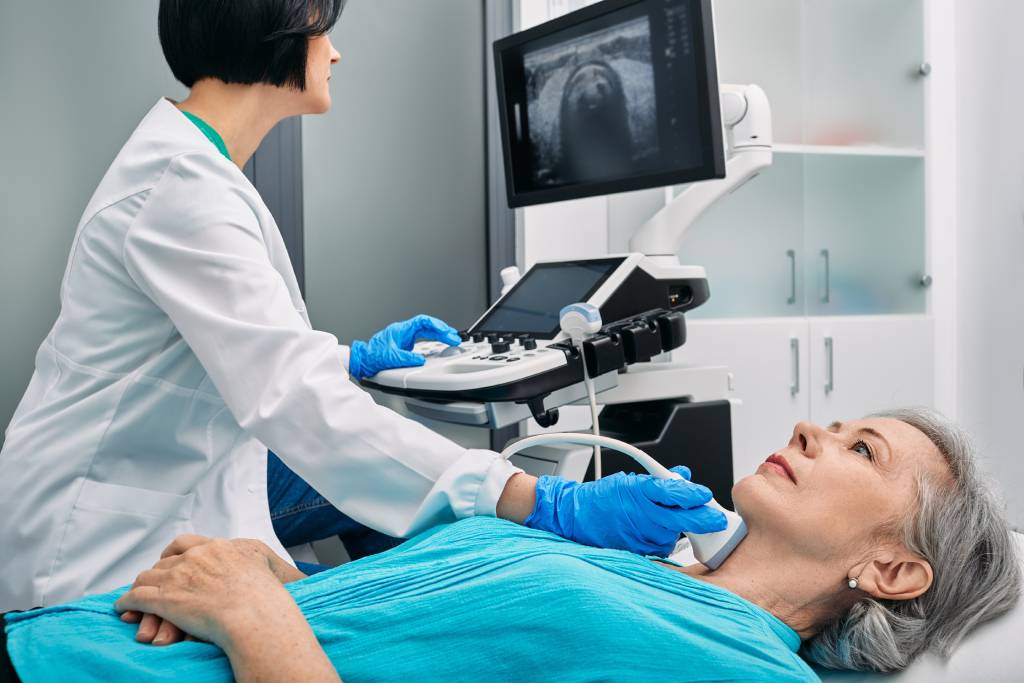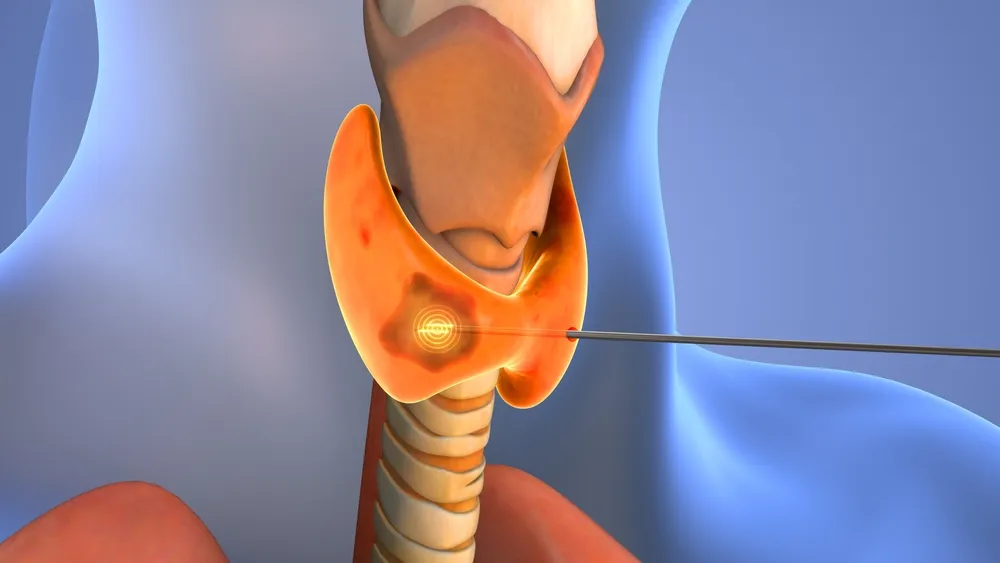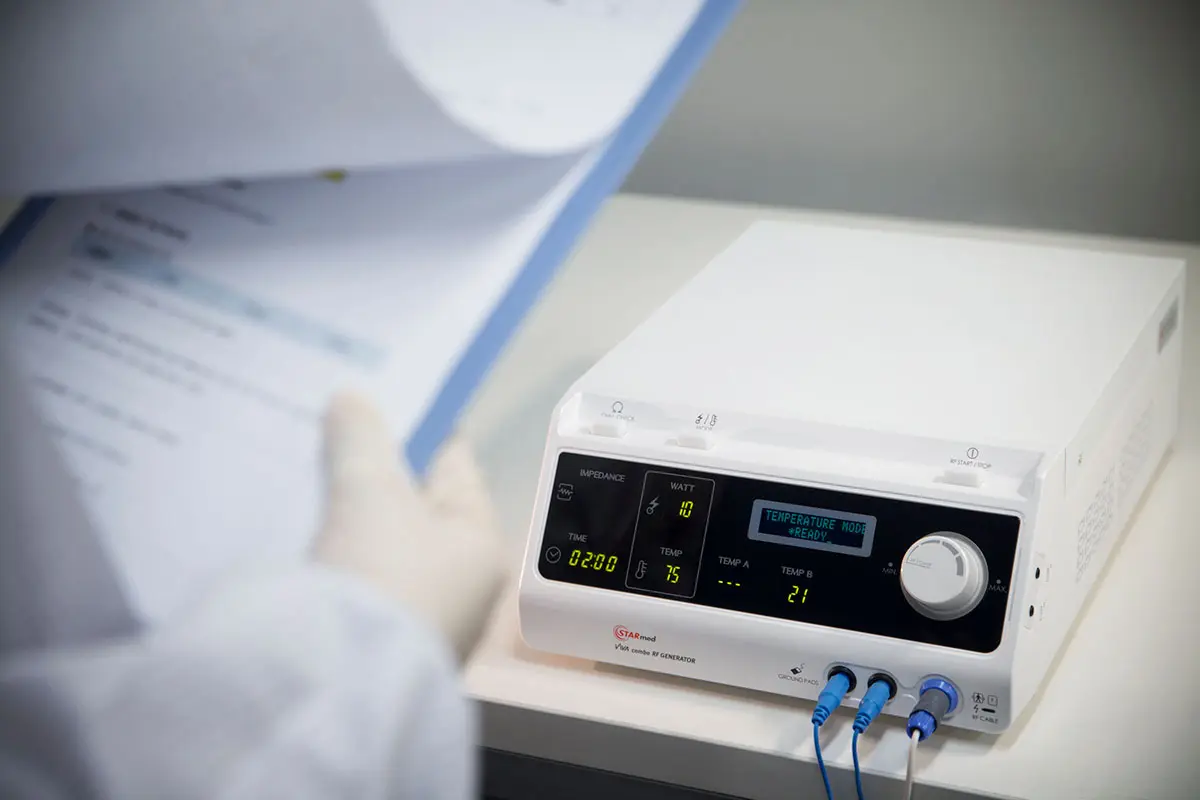TL;DR: Radiofrequency ablation (RFA) is a safe, effective, and minimally invasive alternative to surgery for treating benign thyroid nodules. Here’s what this blog covers:
- Overview of common thyroid nodule treatments
- Pros and cons of surgery vs. nonsurgical options
- How RFA works and when it’s indicated
- Efficacy data showing high nodule shrinkage rates
- Patient satisfaction and cosmetic benefits of RFA
- Why RFA is a growing standard in thyroid care
Discover why RFA is worth considering in your clinical practice.
There are several thyroid nodule treatment options for patients with thyroid nodules that require intervention. Traditional approaches include surgical removal for non-functioning “cold” nodules, and either surgery or radioiodine ablation for hyperfunctioning nodules.
In recent years, approaches have expanded to include thyroid nodule treatment without surgery. Imaging-guided, minimally invasive techniques like radiofrequency ablation (RFA) are gaining traction worldwide. These outpatient procedures aim to shrink or destroy thyroid nodule tissue without damaging healthy tissue. As a result, patients see a significant reduction in symptoms without the need for lifelong medications.
In this blog, we’ll explore the most common thyroid nodule treatments and discuss why RFA stands out. Continue reading to learn why RFA thyroid nodule treatment is a safe, efficacious option for well-selected candidates.
The Most Common Thyroid Nodule Treatment Options
There are many thyroid treatment options, but their approaches, side effects, and level of volume reduction vary. We’ll provide an overview of the most common treatment approaches below.
Thyroidectomy
Thyroidectomy remains the standard for many symptomatic benign nodules or those suspicious for cancer. Surgery guarantees nodule removal, leading to 100% volume reduction.
However, that guarantee comes at the cost of:
- A neck incision
- The need for general anesthesia
- A hospital stay
- Heightened risk of complications like nerve injury or voice changes
- Heightened risk of hypoparathyroidism
Moreover, even a partial thyroidectomy can lead to hypothyroidism in about 20–30% of patients. This may necessitate a need for lifelong medications.
Percutaneous Ethanol Ablation (PEA)
Percutaneous ethanol ablation involves injecting high-concentration ethanol into the thyroid nodule. The process causes cellular dehydration and coagulative necrosis of the tissue.
Clinically, PEA is the first-line nonsurgical treatment for benign, predominantly cystic thyroid nodules. It leads to substantial volume reduction and symptom relief in recurrent or symptomatic cystic lesions.
Laser Ablation (LA)
Laser ablation uses a thin optical fiber to deliver focused laser light into the nodule. There, it is converted to heat through photon scatter. This process induces a localized zone of thermal coagulative necrosis, destroying targeted thyroid tissue.
LA is typically used for solid benign thyroid nodules (especially nonfunctioning nodules). The goal is to achieve significant volume reduction and alleviate compressive or cosmetic symptoms as a nonsurgical alternative.
Microwave Ablation (MWA)
Microwave ablation uses a needle antenna that generates a high-frequency electromagnetic field within the thyroid nodule. The energy causes rapid oscillation of polar molecules and frictional heating of the tissue. This results in a thermal injury, which produces coagulative necrosis.
MWA is used as a minimally invasive treatment for symptomatic benign thyroid nodules (usually nonfunctioning). It can offer nodule volume reduction and symptom improvement in patients who prefer to avoid surgery.
Radiofrequency ablation
Radiofrequency ablation uses an RF generator and electrode to deliver high-frequency alternating current into the target nodule. The current agitates ions in the tissue to generate frictional heat. This process causes thermal coagulative necrosis of the lesion.
RFA is a well-established ultrasound-guided ablation for symptomatic benign solid thyroid nodules. It is also used for local control of recurrent thyroid cancers or small malignant nodules in select patients.
RFA has been standard care in some countries for over a decade with the most number of clinical articles backing up its efficacy. Recently, the U.S. has seen rapid growth in the adoption of RFA for thyroid nodules. As clinical data and patient demand grow, more centers and practitioners have started offering RFA, and that number only continues to climb.
We’ll look into the reasons why below.

Efficacy of RFA Thyroid Nodule Treatment
One reason why RFA thyroid nodule treatment has generated excitement is its high efficacy. Multiple studies have documented significant volume reduction and durable symptom relief.
Foremost, RFA achieves substantial nodule shrinkage. Typical volume reduction ratio (VRR) at 6 to 12 months post-RFA ranges from about 65% up to 90%. For example, a 2025 study found an 83% reduction inaverage nodule volume at 12 months. This shrinkage translates to marked improvement in compressive symptoms and cosmetic concerns for patients
By contrast, surgery removes the nodule entirely, but at the expense of removing healthy thyroid tissue. RFA’s goal is to shrink the nodule while leaving the thyroid gland intact. Patients avoid the need for lifelong thyroid hormone in virtually all cases of benign nodule ablation.
RFA’s efficacy in avoiding surgery altogether is also very high. In one study, only 4.4% of patients ultimately needed a thyroidectomy in the years after undergoing RFA. That means over 95% were effectively treated without ever requiring an operation. In cases where nodules either regrow or do not sufficiently shrink, a repeat ablation can often be performed.
Patient Satisfaction and Quality of Life Outcomes of RFA vs Surgery
RFA has demonstrated excellent patient satisfaction and quality of life improvements in comparative studies. Because RFA is scar-free and has minimal downtime, many patients prefer it over surgery when given the choice.
Foremost, thyroid surgery typically leaves a neck scar. RFA, by contrast, involves only a needle puncture.
Consider one study comparing RFA to surgery. In the study, 92% of patients in the RFA group were fully satisfied with their cosmetic results. Only 69% of patients in the surgery group were fully satisfied with the cosmetic results of their procedure.
Patients also report high satisfaction with the quick recovery after RFA. The ability to return to normal life almost immediately is a huge advantage. Because patients can resume normal activities in as little as 24 hours, there is very little loss of productivity. This makes it enticing for patients with careers, as well as those with obligations such as caregiving.
In terms of symptom relief, both surgery and RFA are effective. However, RFA’s lack of side effects contributes to an overall smoother post-treatment experience.
Learn More About Minimally Invasive Thyroid Treatment Options
Radiofrequency ablation of thyroid nodules represents a paradigm shift in how we approach benign thyroid lesions. Data on efficacy, safety, and patient satisfaction make a strong case for RFA as a standard thyroid nodule treatment option.
Learn more about thyroid nodule RFA treatments and how to adopt the procedure in your practice.





